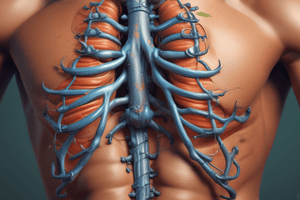Podcast
Questions and Answers
What is considered the primary characteristic of muscle tension dysphonia (MTD)?
What is considered the primary characteristic of muscle tension dysphonia (MTD)?
- Reduced laryngeal mobility
- Insufficient vocal fold closure
- Overactive respiratory muscles
- Intrinsic and extrinsic laryngeal muscle imbalance (correct)
Which finding is indicative of excessive musculoskeletal tension during a manual examination?
Which finding is indicative of excessive musculoskeletal tension during a manual examination?
- High mobility of the laryngeal complex
- Normal phonation with no discomfort
- Pain with palpation, especially more severe on one side (correct)
- Increased space between the hyoid and thyroid cartilage
Which of the following is NOT typically assessed during manual examination related to muscle tension in MTD?
Which of the following is NOT typically assessed during manual examination related to muscle tension in MTD?
- Palpation of the cricothyroid muscles
- Thyrohyoid space at rest and during phonation
- Thickness of the vocal folds (correct)
- Mobility of the laryngeal complex
What was found in the radiographic study comparing people with MTD and control participants?
What was found in the radiographic study comparing people with MTD and control participants?
What is currently unknown regarding the manual tension examination for muscle tension dysphonia?
What is currently unknown regarding the manual tension examination for muscle tension dysphonia?
Flashcards
Musculoskeletal Tension in Voice Disorders
Musculoskeletal Tension in Voice Disorders
Muscle tension in the larynx can contribute to voice problems, particularly in Muscle Tension Dysphonia (MTD).
Manual Examination of Laryngeal Muscles
Manual Examination of Laryngeal Muscles
A physical assessment of the muscles around the larynx to identify tension and assess voice quality.
What does normal laryngeal muscle palpation feel like?
What does normal laryngeal muscle palpation feel like?
Palpable space between the hyoid bone and thyroid cartilage, and good mobility of the larynx.
Signs of Excessive Laryngeal Muscle Tension
Signs of Excessive Laryngeal Muscle Tension
Signup and view all the flashcards
MTD vs. Control Subjects: Hyoid & Thyroid Position
MTD vs. Control Subjects: Hyoid & Thyroid Position
Signup and view all the flashcards
Study Notes
Muscle Imbalance in Myofacial Dysphonia (MTD)
- Intrinsic and extrinsic laryngeal muscle imbalance is a primary characteristic of MTD.
- Manual examination of laryngeal musculoskeletal tension rapidly assesses muscle tension's role in voice quality.
- This differentiation aids in accurate diagnosis and treatment planning.
Manual Examination Protocols
- Examination includes palpation of suprahyoid muscles, hyoid bone horns, thyroid cartilage, thyrohyoid space, and sternocleidomastoid muscle.
- Suprahyoid tension and thyrohyoid space are assessed at rest and during phonation, along with lateral mobility.
- Some protocols include palpation of thyrohyoid, cricothyroid, and pharyngolaryngeal (inferior constrictor and posterior cricoarytenoid) muscles.
- Normal findings involve palpable space between the hyoid and thyroid cartilage, and laryngeal mobility.
- Abnormal findings include one-sided pain, reduced/absent thyrohyoid space (at rest or during phonation), muscle knots, high hyoid/thyroid carriage, and difficulty laterally moving the larynx.
Reliability and Radiographic Studies
- Intra- and inter-examiner reliability data for manual tension examination are currently unavailable.
- Sensitivity and specificity of abnormal findings are unknown.
- Radiographic studies of laryngeal position in MTD show no difference in hyoid/thyroid cartilage location at rest between control participants and those with MTD.
- During phonation, control participants lower their hyoid more than participants with MTD, and MTD participants raise their thyroid cartilage more.
Studying That Suits You
Use AI to generate personalized quizzes and flashcards to suit your learning preferences.
Description
Explore the intricacies of muscle imbalance as it relates to Myofacial Dysphonia (MTD). This quiz covers the characteristics of MTD, the importance of manual examination protocols, and how they assist in diagnosis and treatment planning. Test your knowledge on laryngeal muscle assessment techniques and their implications for voice quality.




